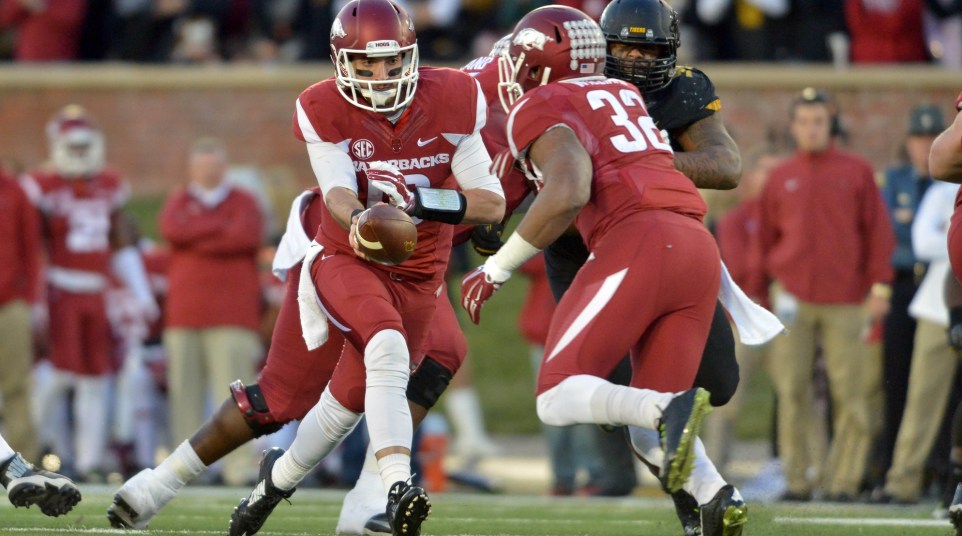Post-spring strengths and weaknesses: Arkansas
Arkansas lurched into gear at the end of Bret Bielema’s second season as its defense so badly bludgeoned LSU and Ole Miss that the Razorbacks couldn’t help but end an SEC winless streak.
The Hogs nearly knocked off eventual SEC champion Alabama at home, creating some strong narratives about the margin from top to bottom in the feared SEC West.
Arkansas exits the spring with hope of vaulting up the division at least a few rungs and out of last place. Bielema’s Razorbacks are starting to look pretty similar to the program he left behind at Wisconsin in terms of mindset, strengths and weaknesses.
Will it be enough to win more than seven games? We’ll start to get our answer in four months. But until then, here’s a look at the team’s strengths and weaknesses following spring practice.
STRENGTHS
- Running game: The team returns four of its five starting offensive linemen, despite some shuffling of positions. If anything, the Hogs are even better positioned up front to block for the running backs in ’15. Oh, and there’s Jonathan Williams and Alex Collins, both of whom rushed for more than 1,000 yards last season. The team looked thin at running back due to an injury (Juan Day) and an ejection (Korliss Marshall), but Kody Walker, primarily a fullback, has proven he can carry the ball when needed. Bielema has all the pieces he needs to pound the football.
- Tight ends: Arkansas lost a sixth-round pick in A.J Derby, a developmental project with upside at the NFL level. But the team should field the best group of tight ends in the SEC. Hunter Henry is a clear All-SEC candidate and just a junior — unfortunately, for opposing defenses. And Jeremy Sprinkle, a 6-foot-6 junior, proved this spring he’s a reliable pass-catching option worthy of staying on the field in the team’s nearly-exclusive two-tight end sets. Alex Voelzke is a very solid third option.
- Defensive coordinator Robb Smith: I have a sneaking suspicion we’re going to be talking about Smith as one of the conference’s most “underrated” coordinators after the season. The perception is that Arkansas’ front seven should regress with the loss of the Bermuda Triangle, all of whom got selected in the NFL draft. But Smith’s attention to detail and demand for physicality seem to be perfect fits in Fayetteville. I expect the defense to be very good once again, at least as big of an asset as the running game.
WEAKNESSES
- Linebackers: Brooks Ellis should be fine replacing Martrell Spaight at the weakside linebacker spot featured in this defense. Beyond that, the group seems shaky. Josh Williams is athletic enough to provide some pass rush from the strongside linebacker spot. Khalia Hackett currently projects as the middle linebacker, but he’s just a sophomore-to-be. Randy Ramsey may or may not be eligible according to Arkansas and the NCAA, and then must get the Bielema stamp of approval to even have a spot on the team. At best, the linebackers are thin; at worst, they’re a liability.
- Lack of big-time receivers: Keon Hatcher appears to be the only legitimate threat at receiver. No offense, Razorbacks, but Jared Cornelius, Cody Hollister and Drew Morgan aren’t scaring anybody. Another intriguing candidate, the 6-foot-6 Kendrick Edwards, is off the team for now, with a chance to come back. Jojo Robinson, thought to have significant upside, didn’t even make the team’s three-deep after spring practice, and Damon Mitchell, another potential emerging player, is buried.
- SEC West: The Razorbacks return the majority of starters on both sides of the ball (eight on offense, seven on defense, according to Phil Steele). The only major losses came in the front seven, and for the most part Arkansas is equipped to replenish there. The problem? The Hogs finished last in the SEC West with more or less a replica of this team in 2014. Alabama and Auburn have legitimate national championship hopes, Ole Miss is in “win now” mode, LSU and Texas A&M are loaded with NFL talent and Mississippi State still has Dak Prescott.

